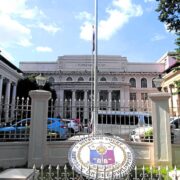Long wait for justice continues

The nearly three decades of legal battle over the environmental damage caused by the Marcopper mining disaster in the early 1990s finally came to an end after the Court of Appeals (CA), in a decision promulgated on Oct. 3, approved a $100-million (P5.8 billion) settlement agreement between the provincial government of Marinduque and Barrick Gold Corp. of Canada. However, it does not end the long wait for justice for the victims of the mining tragedy.
Considered one of the worst mining and pollution disasters in Philippine history, at least 36 people died from heavy metal contamination caused by the accidental spilling of toxic mine waste that also left the Boac River dead. The Marcopper Mining Corp. fiasco actually involved two incidents. On Dec. 6, 1993, the siltation dam of Marcopper collapsed and flooded the villages of Bocboc and Magapua in Mogpog, causing extensive damage to property and agriculture. Nearly three years later on March 24, 1996, a plug in a drainage tunnel at Marcopper’s Tapian Pit failed, releasing about 200 million tons of toxic mine tailings into the Makulapnit and Boac rivers.
But more than the damage caused by the disaster, the Marcopper case was proof that some communities hosting large-scale mines benefit very little from them. A paper published by the Asian Journal of Business Ethics in December 2014, titled “Corporate and Public Governance in Mining: Lessons from the Marcopper Mine Disaster in Marinduque, Philippines,” noted that Marcopper was one of the world’s biggest copper mines when it was operating from 1969 to 1996, employing between 1,000 and 1,500 workers.
Impressive figures
During the mine’s lifetime, it said Marcopper claimed to have contributed $1.3 billion in foreign exchange earnings, paid P6.5 billion in direct and indirect taxes, generated P635 million in domestic business, paid out over P3.3 billion in employee salaries and benefits, and contributed P347 million in the form of community assistance projects and subsidized electricity.
“Contrast these impressive figures with the fact that Marinduque [in 2014] is a fourth-class province in terms of income with a poverty incidence of almost 30 percent. Statistics such as these lend weight to the assertions made by residents … that 27 years of large-scale mining failed to generate benefits for the people of the province,” it lamented.
While the case resolved by the CA had its roots in a petition for a writ of kalikasan (a process to seek court orders for respondents to stop damaging activities and to restore the environment) filed at the Supreme Court in 2011 by some residents, who were later joined by the Marinduque provincial government as intervenor, it was only on April 4, 2025, that Barrick and the local government entered into a settlement agreement.
Real danger
The CA found the settlement to be in order and approved it as the “complete and final adjudication” of the case. “It is only but prudent for this Court to write finis to this case and grant the Parties’ Urgent Joint Omnibus Motion not only to seal a final settlement of the case but, more importantly, for the people of Marinduque, long burdened by the tragedy, to finally partake of its benefits,” the CA said in the ruling written by Associate Justice Jaime Fortunato Caringal.
Barrick will pay the $100 million over three years, with the funds to be remitted to the provincial government’s treasury account. Under the deal, all funds are to be used by the provincial government “for lawful purposes and for the benefit” of the province. However, in issuing a broad statement like this, the court gives the local government so much room for discretion on how the money will be spent. Given the widespread corruption being unearthed by the ongoing investigation into anomalous flood-control projects, there is real danger that the settlement deal will not benefit the people of Marinduque.
Complete transparency
The provision in the agreement that Marinduque officials “shall not use the money, directly or indirectly, for any act that constitutes graft or corruption” is also not enough. Complete transparency must be required of every peso of the settlement money that the provincial government will spend. The money must go to the families of the victims of the Marcopper tragedy, the compensation or rehabilitation of the damaged property and farms, and genuine efforts to bring back to life the Boac River, a source of livelihood for many residents that remains contaminated with heavy metal today.
Justice for the people who suffered from the Marcopper disaster is not served with the CA’s decision alone. It is now up to the local government of the island province to ensure that the settlement money will go to its intended beneficiaries and not be lost to corruption or nonessential projects such as basketball courts or public parks.
To repeat the court ruling’s intent, the settlement agreement is “…for the people of Marinduque, long burdened by the tragedy, to finally partake of its benefits.”





















